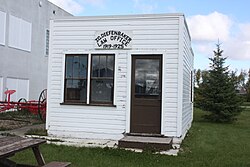Wakaw
Town of Wakaw | |
|---|---|
 Elevator Road (2009) | |
| Coordinates: 52°38′38″N 105°44′6″W / 52.64389°N 105.73500°W | |
| Country | Canada |
| Province | Saskatchewan |
| Census division | No. 15 |
| Rural Municipality | Hoodoo No. 401 Fish Creek No. 402 |
| Post office Founded | May 1, 1905 |
| Village Incorporated | December 26, 1911 |
| Town Incorporated | August 1, 1953 |
| Government | |
| • Mayor | Steve Skoworodko |
| • Administrator | Terrence Schneider |
| • Governing body | Wakaw Town Council |
| Area | |
| • Land | 3.12 km2 (1.20 sq mi) |
| Population (2011) | |
• Total | 985 |
| Time zone | CST |
| Postal code | S0K 4P0 |
| Area code | 306 |
| Highways | |
| Website | Wakaw |
| [1][2] | |
Wakaw, Saskatchewan, is a town 90 kilometres (56 mi) northeast of Saskatoon and 66 kilometres (41 mi) south of Prince Albert. It is about halfway between the two cities and is served by Highway 2, Highway 41, and Highway 312. Wakaw is in hilly partially forested country east of the South Saskatchewan River. The area is part of the aspen parkland biome.
Wakaw is a Cree word meaning "crooked". The name was taken from nearby Wakaw Lake and applied to the town.[3]
History
[edit]The area was peopled primarily by settlers of Eastern European origin.[3] The town was home to Prime Minister John Diefenbaker and his first wife Edna Brower. Diefenbaker opened his first law office in Wakaw from 1919 to 1925.[3]
Wakaw was founded on December 26, 1911 after 21 residents petitioned the Department of Municipal Affairs, asking for the incorporation of the Village of Wakaw. It was located on Section 30, Township 42, Range 26, west of the 2nd Meridian, land donated to the town by Anthony Goller who immigrated to Canada in 1902. When the railroad was built the town was moved to its present location. On August 1, 1953 Wakaw was incorporated as a town.[3]
The community recognized its 100th anniversary by holding Centennial Celebrations on July 21 to 31, 2011.[4]
There are about 800 cabins at nearby Wakaw Lake, some of which are occupied year round.[3]
Demographics
[edit]In the 2021 Census of Population conducted by Statistics Canada, Wakaw had a population of 978 living in 421 of its 496 total private dwellings, a change of 6.1% from its 2016 population of 922. With a land area of 3.09 km2 (1.19 sq mi), it had a population density of 316.5/km2 (819.7/sq mi) in 2021.[5]
| 2011 | |
|---|---|
| Population | 985 (+14.0% from 2006) |
| Land area | 3.12 km2 (1.20 sq mi) |
| Population density | 315.9/km2 (818/sq mi) |
| Median age | 49.5 (M: 48.2, F: 51.1) |
| Private dwellings | 473 (total) |
| Median household income |
Amenities
[edit]Businesses in Wakaw include grocery stores, a pharmacy, restaurants, insurance agencies, and six places of worship. Outside of town limits, at the conjunction of Highway 2 and Highway 41, there are two gas stations and restaurants.
The town's school, Wakaw School, teaches students from pre-kindergarten through grade twelve.

Notable people
[edit]- Dave Balon - professional ice hockey player and coach
- Harvey Cenaiko - former Solicitor General of Alberta and policeman
- Tom Courchene - economist and professor; Officer of the Order of Canada
- John Diefenbaker - 13th Prime Minister of Canada
- James Latos - professional ice hockey player for the New York Rangers and coach
- Dave Michayluk - professional ice hockey player for the Philadelphia Flyers and Pittsburgh Penguins
- Linden Vey - professional ice hockey player for the ZSC Lions organization in the National League (NL); Olympic bronze medalist PyeongChang 2018
See also
[edit]
- List of communities in Saskatchewan
- List of francophone communities in Saskatchewan
- List of place names in Canada of Indigenous origin
- List of towns in Saskatchewan
- Wakaw Airport
References
[edit]- ^ National Archives, Archivia Net, Post Offices and Postmasters, retrieved 1 December 2013
- ^ Government of Saskatchewan, MRD Home. "Municipal Directory System". Retrieved 1 December 2013.
- ^ a b c d e "Wakaw". Encyclopedia of Saskatchewan. Canadian Plains Research Center, University of Regina. 2006. Retrieved 13 February 2013.
- ^ Wakaw Recorder
- ^ "Population and dwelling counts: Canada, provinces and territories, census divisions and census subdivisions (municipalities), Saskatchewan". Statistics Canada. 9 February 2022. Retrieved 1 April 2022.
- ^ "2011 Community Profiles". 2011 Canadian census. Statistics Canada. 21 March 2019. Retrieved 22 December 2012.
- ^ "2006 Community Profiles". 2006 Canadian census. Statistics Canada. 20 August 2019.
- ^ "2001 Community Profiles". 2001 Canadian census. Statistics Canada. 18 July 2021.
External links
[edit] Media related to Wakaw, Saskatchewan at Wikimedia Commons
Media related to Wakaw, Saskatchewan at Wikimedia Commons Canada portal
Canada portal



